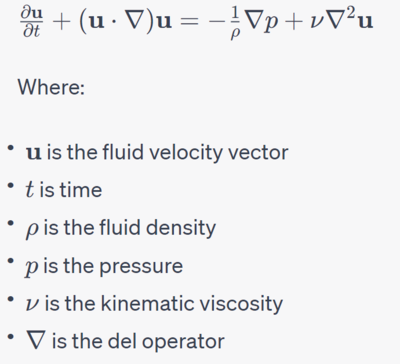Navier-Stokes Equations
The Navier-Stokes equations are a set of partial differential equations that describe the motion of fluid substances. Named after Claude-Louis Navier and George Gabriel Stokes, these equations provide the foundation for the field of fluid dynamics and have applications that range from weather forecasting to aircraft design and beyond.
Historical Background
Claude-Louis Navier initially formulated the equations in 1822 by extending Euler's equations for fluid flow to include viscous effects. George Gabriel Stokes later refined these equations, and hence the equations bear their combined names. The Navier-Stokes equations have been an essential tool in fluid dynamics and have contributed significantly to both academic research and practical engineering solutions since their derivation.
Mathematical Formulation
The incompressible Navier-Stokes equations in vector form can be stated as:
The equation balances the forces acting on a fluid element: the changes in momentum (left-hand side) are equated to the forces from pressure and viscosity (right-hand side).
Types of Flows
The Navier-Stokes equations can describe various kinds of flows, such as:
- Laminar Flow: Fluid flows smoothly in parallel layers.
- Turbulent Flow: Chaotic flow with swirls and eddies.
- Compressible and Incompressible Flows: Flows where density changes significantly or remains roughly constant, respectively.
- Steady and Unsteady Flows: Flows that are time-independent or time-dependent, respectively.
Applications
- Aerospace Engineering: For aerodynamic design and wind tunnel testing.
- Weather Forecasting: To model atmospheric flows.
- Biomedical Engineering: In modeling blood flow.
- Automotive Engineering: For vehicle aerodynamics.
- Environmental Science: In modeling pollutant dispersal in air and water.
Challenges and Unsolved Problems
Solving the Navier-Stokes equations for all but the simplest cases typically requires numerical methods. Even then, there are limitations:
- Existence and Uniqueness: One of the Clay Millennium Prize Problems is to prove or provide a counter-example of the existence and uniqueness of solutions to the Navier-Stokes equations in three dimensions.
- Turbulence Modeling: Accurately capturing turbulence remains a significant challenge and active area of research.

